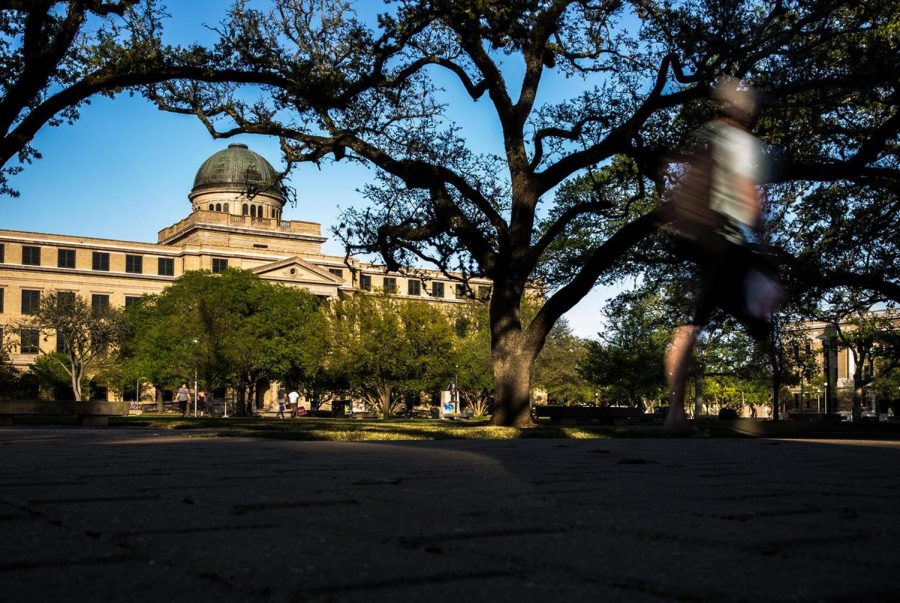Texas A&M System to offer some on-campus classes in fall
SHELBY KNOWLES/The Texas Tribune
The plan will apply to Texas A&M’s flagship campus and its 10 other institutions.
May 31, 2020
Next fall, Texas A&M students may be assigned which days they’re allowed to go to class and which days class they’ll be asked to stay home and follow class along from their laptops, the Texas Tribune reported.
If there are 50 people in a math class, for example, half of them would be allowed to show up Tuesday while the other half views online. On Thursday, the students would swap places.
This is one of several measures in a plan Texas A&M University System officials approved last week in an effort to create social distance in crowded classrooms. The guidance will apply to each of the system’s 11 institutions. A&M is the first major university system in the state to formally adopt plans for the fall, although officials warned there is much more work to be done before classes begin in August.
A message from #PresYoung on plans for in-person fall semester: https://t.co/IA8aNz7Fls
• Fall semester classes will begin August 19.
• We will have enhanced methods of cleaning & disinfecting on campus.
• Students will not be required to return to campus after Thanksgiving. pic.twitter.com/tgUnc6ouqH— Texas A&M University (@TAMU) May 29, 2020
The University of Texas at Austin, meanwhile, has announced that on-campus classes will run from August to Thanksgiving and then continue remotely in an effort to limit student travel. The University of Texas System has not yet released concrete guidance on how classes and other activities will proceed at its 14 institutions.
While some face-to-face classes will resume at A&M, many will be conducted in a hybrid model mixing in-person and online instruction. Certain courses will be prioritized for in-person instruction, such as speech, performance and clinical classes.
Officials are also seriously considering lengthening the instructional day and may extend classes through the weekend.
“All courses must be designed to shift to a remote environment if the conditions warrant,” said James Hallmark, the vice chancellor for academic affairs for the A&M System. “If indeed a second wave hits in the fall … our courses will be designed from the start to [transition] with less disruption.”
Hallmark said all meeting spaces, including classrooms, will sharply curtail capacity. For example, a room that typically would accommodate 50 people will instead only allow 15 people at a time. Physical adjustments will be made, such as installing plexiglass separators or other distancing aids.
Residence halls will be open, with students expected to maintain social distancing as much as possible. Students will be discouraged from traveling away from campus, as well as inviting overnight and out-of-town guests. If they do leave campus, they must self-report any exposure to COVID-19 and may need to self-isolate afterwards. Spaces in residence halls will be designated for students who must quarantine themselves.
While sports will resume, Friday’s plan did not include details. Hallmark said the system would be waiting for guidance from the NCAA and specific conferences.
The plan emphasizes flexibility across each of the school system’s campuses, with each university tailoring specific accommodations to its region. Training modules have already been sent to employees, who will soon return to campus.
Officials said they recognized the need to balance campus activities with academics. System Chancellor John Sharp said the campus experience is “invaluable.”
“You can get a degree online, but it’s very hard to become an Aggie online,” Sharp said.
A&M’s flagship campus in College Station has spent $20 million to reimburse students for on-campus services like housing, dining and parking. It is projected to lose up to $27 million more in revenue, which includes canceled events, Laylan Copelin, an A&M spokesperson, said.
The federal stimulus program gave the A&M System $76 million to be split between its campuses, covering revenue losses and providing financial aid for students. The University of Texas System got $172.5 million for its 14 institutions.



